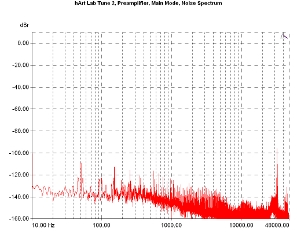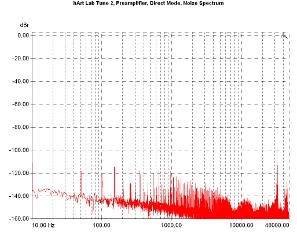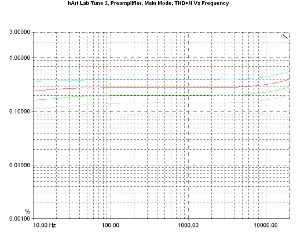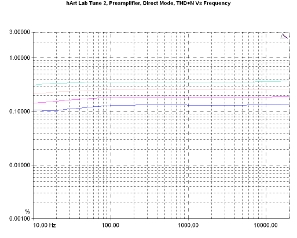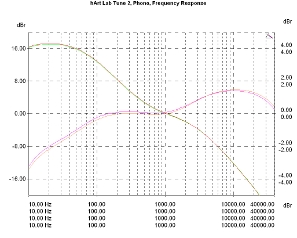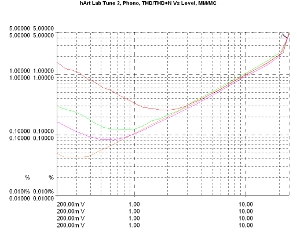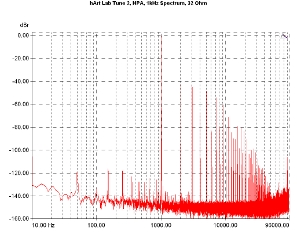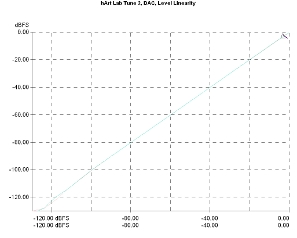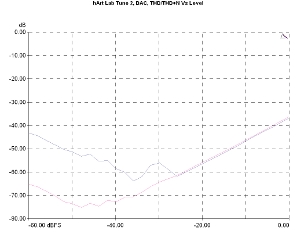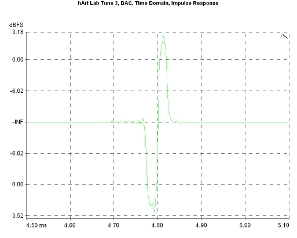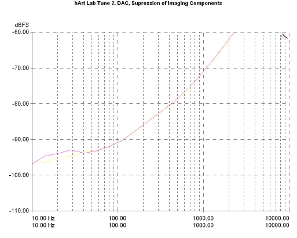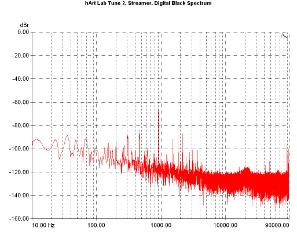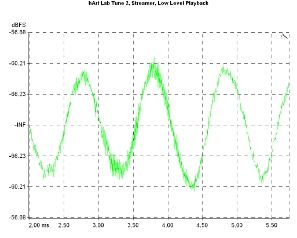about Audio, High Fidelity
& Home Entertainment technologies
pid: 607-2025/10/01 (v1.2)
Privacy Policy
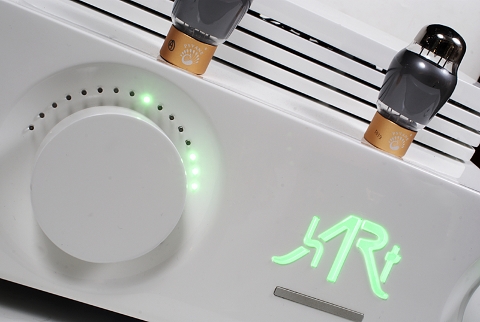
With the test device being the full version, including both the phono preamplifier and the DAC module, the laboratory evaluation of the Tune Two was a lengthy process. The line preamplifier was evaluated from both outputs (Direct and Main), while the measurements of the phono preamplifier and the DAC were taken from the Main output.
The Tune Two proved to be quite sensitive, requiring only 90mVrms at the input to deliver 1Vrms at the output, while with the typical line level input (-10dBV), the output exceeded 3.5Vrms. Overload margins are impressively high, with the Main output surpassing 22Vrms at clipping and the Direct output slightly lower, at around 19Vrms.
The distortion values were as expected for the type of circuit (tube-based, without global feedback), with THD and THD+N measured in the range of 0.4% (1kHz) with mild increase, reaching around 0.5% for high-frequency signals (10kHz). Intermodulation distortion ranged around 0.3%.
In terms of noise performance, the Tune Two emerged as one of the best preamplifiers tested, with a signal-to-noise ratio in the range of -100dB(A) referenced to 1Vrms output level and a dynamic range reaching 105dB from the Direct output. Naturally, performance via the Main output was slightly worse, with the dynamic range "falling" to around 102dB.
Channel crosstalk was measured at -85dB (10kHz), while the tracking of the attenuator was very good, with differences not exceeding 0.2dB across the entire attenuation range (the worst value being +0.19dB).
With a 1kHz signal at the input, the output spectrum includes a strong second harmonic (around -45dBr, referenced to -10dBV input level), followed by harmonics falling below -100dBr after the fourth.
This behavior does not change significantly when transitioning from one output to another (a proof that the buffer has a rather low effect, here) and the only thing one can observe is a change in the composition of the power-line noise.
Line Preamplifier: 1kHz signal spectrum, reference level: 1Vrms, Main output.
Line Preamplifier: 1kHz signal spectrum, reference level: 1Vrms, Direct output.
The noise spectrum, without signal at the input and output via the buffer, is slightly more "lively" in the very low-frequency range, while in direct mode, the preamplifier is more typical with components at 50/100Hz. In both versions, however, the noise floor remains around and below -110dBr and the circuit does not pick up high-frequency noise, despite its complexity, incorporating both a single-board computer and a DAC board.
Line Preamplifier: Noise spectrum. Reference level: 1Vrms, Main output.
Line Preamplifier: Noise spectrum. Reference level: 1Vrms, Direct output.
Distortion relative to frequency exhibits very smooth behavior, with the curves consistently staying below 0.4% across the measurement spectrum. There's a clear dependence of distortion values on level (distortion increases with output level, likely due to the tube stage), but differences between Main and Direct Mode are small in magnitude, with FETs showing a clear (but not significant) tendency of increase with frequency.
Line Preamplifier: THD+N Vs frequency and output level, Main output. Reference level (0dBr): 1kHz/1Vrms. Levels -6dBr (gray curve), -3dBr (green), 0dBr (red), +3dBr (cyan).
Line Preamplifier: THD+N Vs frequency and output level, Direct output. Reference level (0dBr): 1kHz/1Vrms. Levels -6dBr (blue curve), -3dBr (violet), 0dBr (pink), +3dBr (cyan).
The frequency response of the preamplifier is extensive in the case of the Direct output, with the range exceeding 80kHz. From the Main output, the response is somewhat more limited, but still with a large typical range, with the -3dB point just before 70kHz. Channel matching is very good.
With the tube stage involved in both outputs, it's logical for the distortion character to be dictated by the tubes, especially relative to the output level. Differences introduced by the FET buffer stage are visible in the graph but are truly small, while the measurement taking noise into account is -naturally- higher in both cases.
Line Preamplifier: Frequency response, reference level: 1Vrms/1kHz. Direct output (red-green curve), Main output (orange-violet).
Line Preamplifier: Distortion Vs output level, Main and Direct outputs. 1kHz signal, THD (orange and green curve), THD+N (violet and red).
The phono preamplifier requires 0.845mVrms and 0.076mVrms at the input to deliver 1Vrms at the output, for MM and MC respectively, with very good overload margins reaching up to +28dB.
The total distortion is in the range of 0.1%, and the noise is low, at -67dB(A) and -45dB(A) respectively for MM and MC inputs, with a 1Vrms reference level. De-emphasis curve accuracy is good, with a maximum deviation of +1dB, in the very low-frequency range (at the 3180us time constant), while channel differences are very small, in the range of 0.1dB.
The frequency response of the preamplifier (with inverse RIAA equalization applied) is significantly better than the typical requirement of ±3dB, falling within the ±2dB range in the 20Hz-20kHz span.
The distortion versus level graph reveals no surprises, with the MC input naturally being more noisy, in low-level signal measurements, and the profile following that of the line preamplifier from 3Vrms and above.
Phono preamplifier: Frequency response (green, red curve) and RIAA-compensated response curve (orange, violet). Reference level: -10dBV.
Phono preamplifier: Distortion (THD/THD+N) Vs level (1kHz). THD (green curve), THD+N (red), MC input. THD (orange curve), THD+N (violet), MM input.
The headphone amplifier, based on the vacuum tube preamplifier stage, proved capable of driving… everything, or almost everything. With a load of 32-Ohm, it delivered approximately 3Wrms (10.4Vrms), while with a load of 600-Ohm, it reached 524mWrms (17.5Vrms).
In terms of distortion levels, with a 32-Ohm load, it operated at 0.9% (THD, 1kHz) with slight increases in voltage with frequency (1.1%, 10kHz), while with a 600-Ohm load, the values rose slightly above 1%. Similar behavior was observed in intermodulation distortion, with values of 0.7-0.8% (SMPTE) respectively.
Noise measurements of the headphone output proved exemplary good. With a 32-Ohm load, we observed -105dB(A) in reference to the 1/3 of the maximum power, while the crosstalk remained at the typical value of -60dB, for an output terminated with a TRS 6.35mm jack.
With a 1kHz signal at the input, the output spectrum is quite similar to what we obtained for the line preamplifier when the load was 600-Ohm. This means a strong second harmonic (-40dB) and a smooth succession of higher harmonics, which fall below -100dBr after the sixth order, with very low noise from the power supply. With a 32-Ohm load, we have a stronger presence of harmonics and slightly stronger noise from the power supply (which, however, remains around and below -120dBr with reference to 1/3 of the power).
Headphone amplifier: 1kHz signal spectrum, reference level: 1/3 Pmax/32-Ohm load.
Headphone amplifier: 1kHz signal spectrum, reference level: 1/3 Pmax/600-Ohm load.
The THD+N relative to power and load confirms the static measurements for the distortion level and the impression that the headphone output noise is very low.
The DAC measurements were performed using the coaxial digital input, with 24/96 signals, unless stated otherwise.
The output level linearity is among the best we have measured, with the relative curves maintaining their ideal shape even for levels below -110dBFS, a performance that is considered excellent. It should be noted, however, that we are talking about preamplifier measurements and not strictly DAC measurements, which means that the reference voltages are much higher (the 0dBFS of Tune Two corresponds to almost 12Vrms output).
Headphone amplifier: THD+N Vs output power. 600-Ohm load (green curve) and 32-Ohm load (red curve).
DAC: Output level linearity. 1kHz signal, S/PDIF input, 96kHz.
Distortion performance is similarly good. Here, at high levels, the curves follow the behavior of the line stage with distortion values in the -35dB range for signals near 0dBFS, but at low levels, the behavior is also very convincing, with -65dB THD for a -60dBFS level and THD+N in the -45dB range for the same level. The same observation applies here, about the preamplifier levels being very high, close to the converter's limit.
Idle channel noise is very low, with the overall results being below -110dBFS for the entire measurement spectrum.
DAC: Harmonic distortion Vs level. Sample rate 96kHz. THD+N (purple curve), THD (pink).
DAC: Idle channel noise.
The converter does not give the user the option of selecting a digital filter. This has been done by hARt Lab, and their choice is compatible with the overall philosophy of the device, as it is apparent that a slow filter has been selected, aiming for the best possible performance in the time domain.
Indeed, this is achieved with the device having minimal pre-ringing and exemplary decay behavior (observant readers will also notice that the DAC is phase-reversing).
DAC: Digital filter response. 44.1kHz (orange curve), 96kHz (violet), 176.4kHz (blue).
DAC: Time domain response.
Of course, there is a catch. The good time domain response, resulting from the relaxed digital filter, leads to increased noise due to imaging noise components within the acoustic spectrum. The relative curves are clear about this. We can't have it all, after all!
The evaluation of the streamer was done with the preamplifier connected to the network via Ethernet and the signal files sourced from a NAS device. The zero signal -digital black- playback shows a process with low noise, slightly increased in the very low-frequency region, while the device maintained its exemplary behavior above 1kHz, with minimal components above -90dBr.
DAC: Suppression of imaging components.
Streamer: Noise spectrum, Digital Black playback, Reference level 1kHz/0dBFS, 96kHz.
The playback of very low-level signals fully satisfied us. The sine wave, although it carries visible traces of high-frequency noise, maintains its geometry to a very high percentage, a performance that should be considered very good.
Finally, the playback of the monotonicity signal was at a typically good level, with noticeable noise both at individual levels and in the transition interval from the falling to the rising sequence.
Streamer: Very low-level signal playback (-80dBFS, 16-bit/44.1kHz)
Streamer: Monotonicity waveform playback (16-bit/44.1kHz).
Previous | Next | More Reviews



